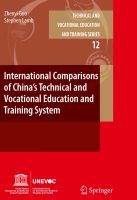
The UNESCO-UNEVOC International Centre: Who We Are | What We Do | Working With Us | Get in Touch
The UNEVOC Network: Learn About the Network | UNEVOC Network Directory
For Members: UNEVOC Centre Dashboard
Thematic Areas: Inclusion and Youth | Digital Transformation | Private Sector Engagement | SDGs and Greening TVET
Our Key Programmes & Projects: BILT: Bridging Innovation and Learning in TVET | Building TVET resilience | TVET Leadership Programme | WYSD: World Youth Skills Day
Past Activities: COVID-19 response | i-hubs project | TVET Global Forums | Virtual Conferences | YEM Knowledge Portal
Our Services & Resources: Publications | TVET Forum | TVET Country Profiles | TVETipedia Glossary | Innovative and Promising Practices | Toolkits for TVET Providers | Entrepreneurial Learning Guide
Events: Major TVET Events | UNEVOC Network News

Guo, Zhenyi; Lamb, Stephen
2010, English, 198 p., Hardcover
ISBN: 978-90-481-8742-3 (Print),
978-90-481-8743-0 (Online)
China is experiencing an unprecedented phenomenon: breakneck industrialization on a scale and at a pace not seen before. It is trying to achieve in just a few decades what Western nations took more than a century to do. The arrival in the country’s cities of tens of millions of rural dwellers, at most semi-skilled, has put huge strain on the country’s system of technical and vocational education and training, known as TVET.
How have the Chinese authorities and their education administrators responded? Is China’s TVET system adapting to the rapidly evolving needs of its industry? Using the province of Yunnan as a subject, this detailed case study is a closely argued and sanguine analysis of the operation of TVET in China.
The authors deployed a set of internationally comparable criteria to offer a searching assessment of current performance, at the same time documenting areas of strength and weakness. The question the authors’ methodology answers is how well China’s TVET system is performing compared to technical and vocational education structures in other countries. In fact, they discover that in Yunnan, a province representative of the challenges faced nationwide, much has indeed been done, from a wholesale overhaul of programmes to make them relevant to industry requirements, to major investment in infrastructure. Teacher training has been reformed, and take-up of professional master’s and doctoral courses has been encouraged. Joint initiatives with bodies such as UNESCO have improved training and vocational education at high-school level.
While there is a strong international history of such comparative evaluations, which are essential for policy makers to benchmark their administration, few studies have included China despite the enormous amount of value that can be learned from that country’s experience. This work will provide vital material for researchers, governments and development agencies alike.
Table of contents and introduction![]()
Order
Buy this book from Springer Science and Business Media![]()